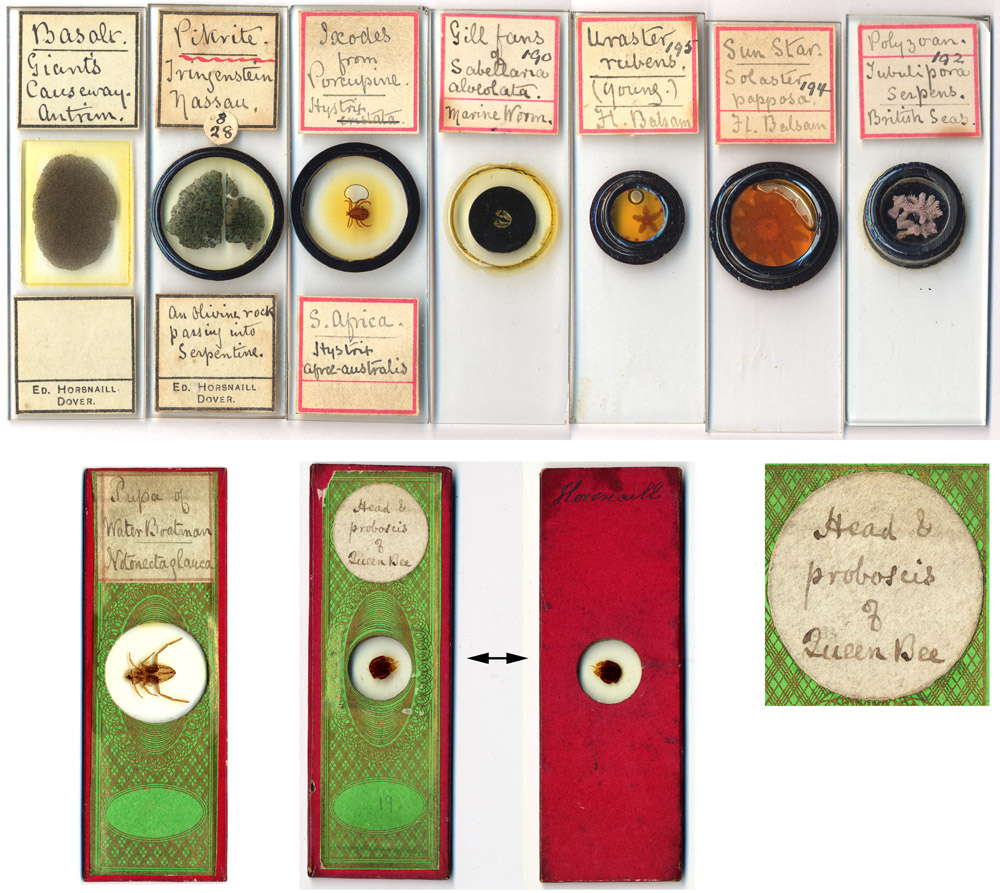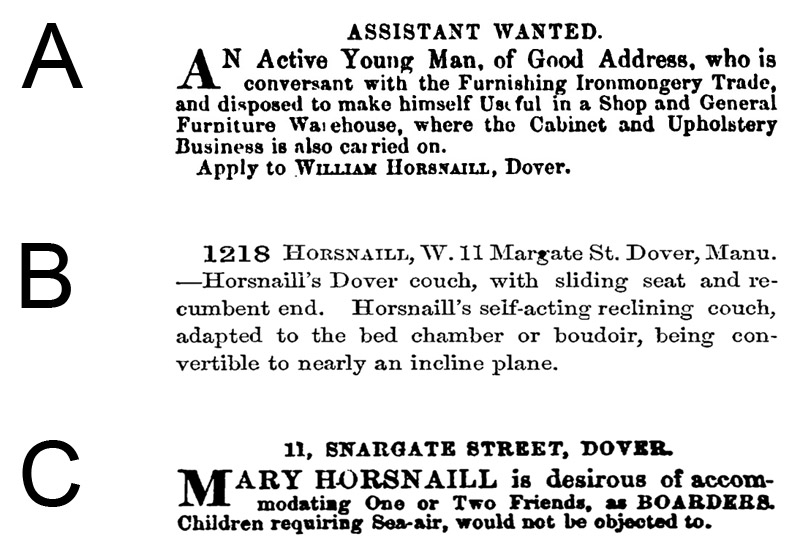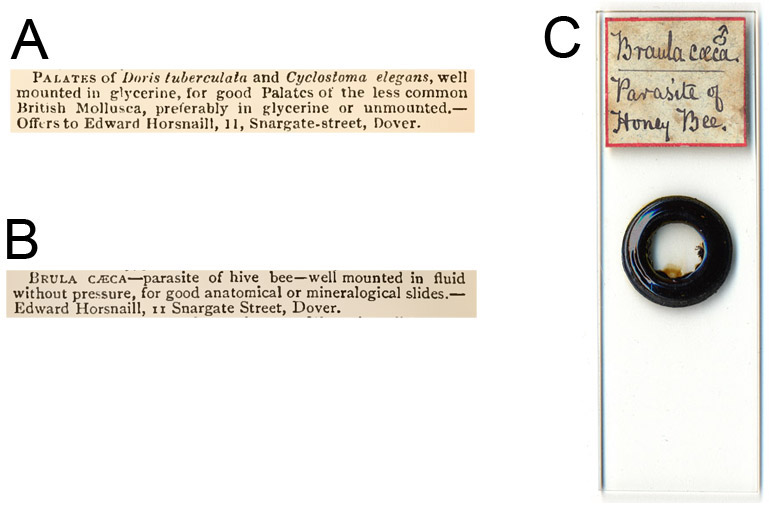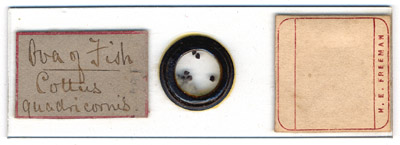Edward Horsnaill, 1836 – 1913
by Brian Stevenson
last updated October, 2014
Edward Horsnaill was an amateur
naturalist, particularly noted for his studies of sea life near his home in
Kent. He was born and raised in Dover, then moved down the coast to Folkestone
in his later life. Horsnaill left behind a substantial number of microscope
slides, some bearing labels pre-printed his name and address (Figure 1). There
are no indications that Horsnaill ever sold any of his slides, so all would
have come either from his personal collection or from exchanges with other
naturalists. Notably, in 1900 Richard Kerr acknowledged assistance in producing
his book Hidden Beauties of Nature
from “Mr. C. W. Locke, the well-known
optical lantern and slide maker, and from Mr. E. Horsnaill, the marine biologist, of Dover”. Thus, Horsnaill was known to colleagues as a
biologist, not a slide maker. Horsnaill’s primary occupation was furniture
construction and upholstery.

Figure 1. Examples of microscope slides produced by Edward
Horsnaill. Numerous mounts of thin-section stones are known, although I located only one published reference to Horsnaill studying minerals, a March, 1900 presentation on flints from Asia Minor. That, plus the use of labels printed with his name, suggest that Horsnaill’s mineral slides were produced later in his life. Also shown on the top row of are balsam mounts of a tick and gill fans from a marine worm, fluid balsam deep-mounts of starfish, and a very deep, dry mount of a polyzoan. Horsnaill wrote on the starfish Uraster rubens and Sun Star (Solaster papposa) in 1871, and the illustrated slides may have been part of the research he conducted for that publication. On the bottom row are two papered slides with Horsnaill’s handwriting. Horsnaill’s name is written on the back of the right slide, in another hand, probably by another biologist with whom he had exchanged slides (see Figures 4 and 5). The style of these slide, involving paper wrappings, indicates that they were produced before those shown in the top row, possibly the 1860s.
Edward was born in 1836, the only known son of William and Mary Horsnaill. William was an ironmonger and furniture maker, inheriting the business at 11 Snargate St., Dover from his father. An 1831 publication referred to the shop as “Horsnaill & Son”. In 1840, Pigot’s Directory recorded William as being a “cabinetmaker & upholsterer, ironmonger, and house agent”. Melville’s 1858 Directory of Kent described the business as a “cabinet, upholstery, and paper hanging warehouse”. An 1851 advertisement in The British Friend sought to recruit an assistant for the “furnishing ironmongery trade” (Figure 2A). Examples of their work are described in the catalogue of the 1853 Great Industrial Exhibition in Dublin (Figure 2B).
Edward’s father had an elder sister named Sarah, who in 1806 married Samuel Wheeler. Sarah and Samuel Wheeler had four children, two of whom survived infancy. The younger surviving son was Edmund Wheeler (1808-1884), who became one of the best known microscope slide-makers of the Victorian era. Wheeler initially worked as an ironmonger, and likely learned the trade with his uncle. Wheeler’s nephew from his wife’s side, Frederick Enock, worked with Wheeler for many years and is also famous for his microscope slide preparations. Interactions between Edward and cousins Edmund and Frederick may have played instructive roles in Edward’s keen interest in microscopy.

Figure 2. (A)
Request for an assistant to help the Horsnaill furniture business, from The
British Friend, January, 1851. Edward was away from home at this time,
attending the Ackworth School.
(B)
Entry information from the Great Industrial Exhibition, Dublin, 1853. The Horsnaills’ street address was misspelled.
(C) Advertisement for boarders, from
The British Friend, 1854.
Edward attended the Ackworth
School for the 1850-51 academic year. This was a well-respected boarding school operated by the Society of Friends (Quakers). He would probably have become familiar with microscope slide makers and Ackworth teachers John Watson and Thomas Sharpe.
Horsnaill attended Ackworth for
only one year. The family may have experienced financial difficulties, and/or
Edward may have been needed at home to work in the business. The 1851 census
described father William as a 75-year old retired upholsterer and operator of a
boarding house. The family advertised in The
British Friend for boarders in 1854 (Figure 2C). Edward’s father died in
1855. Mother Mary continued to run the furniture business until her death in
1865. During 1861, the Horsnaills’ business employed 2 men and 2 boys.
Edward Horsnaill married Sarah
Horsnaill in 1866. She does not appear to have been a close relative, despite
their shared last name. They had 6 children over the next 15 years, five girls
and a boy. The family’s finances seem to have been reasonably decent, as they
employed a young woman as a live-in servant at the times of the 1881 and 1891
censuses.
Edward’s first recorded foray into the sciences was his
joining the Kent Archaeological Society in July, 1861. He joined the East Kent
Natural History Society by 1870. Horsnaill published a 5-page article on “pygmy crustaceans” in Hardwicke’s Science-Gossip in 1870. This
scientific examination of two small crabs of the Dover shoreline was
accompanied with well-drawn figures made by Horsnaill, presumably using a
camera lucida (Figure 3). Regarding Horsnaill’s artwork, the acknowledgment he
received from Robert Kerr in 1900 was for assistance with illustrations for
Kerr’s book. Other identified scientific publications by Horsnaill include an
1871 article on starfish, an 1878 article on an anemone, an 1878 article on
making aquariums and an 1880 article on a parasite of bees, all in Hardwicke‘s Science-Gossip. The two
slides of starfish shown in Figure 1 (above) are of species described by
Horsnaill in his 1871 paper, and probably figured in his research at that time.
Horsnaill contributed chapters to the 1899 book Handbook to Dover, published that year to accompany that year’s
meeting of the British Association for the Advancement of Science, in Dover. It was described as “a special handbook to
Dover and the neighbourhood, containing articles on the history and
antiquities, the geology, the entomology, the vertebrate fauna, the botany, the
climate, the river and tides, the docks and other engineering works, the trade,
commerce, and industries. This book is illustrated with maps and plans, some of
which contain new work. The information given in the maps and plans and the
articles, written by specialists on the subjects they deal with, will, it is
hoped, render the work not only useful on the occasion of the British
Association's visit, but also of some permanent value.”

Figure 3. Some figures from Edward Horsnaill’s 5-page paper on
“Pygmy Crustaceans”, Hardwicke’s Science-Gossip, 1870. Horsnaill also made a
presentation on this subject to the East Kent Natural History Society in 1869.
The highly-detailed illustrations indicate that Horsnaill was skilled at minute
observations and in the use of the camera lucida.
Horsnaill advertised slides for
exchange in Hardwicke’s Science-Gossip
in 1876 and in 1883 (Figure 4). The bee parasite slides offered in 1883 were
probably connected with his studies of that insect which he published on in
1880 (see above). These are the only two exchange offers I found in this
popular scientific magazine, although evidence indicates that he distributed microscope slides not mentioned in those advertisements (Figure 5).

Figure 4. Offers to exchange slides from Edward Horsnaill that were published in Hardwicke’s Science-Gossip during 1876 (A) and 1883 (B). (C) One of Horsnaill’s slides of Braula coeca that he advertised for exchange in 1883 (the insect’s name was misspelled in the Science-Gossip advertisement).

Figure 5. A result of a slide exchange between Horsnaill and a contemporary microscopist, Henry E. Freeman. The labeling indicates that this was produced by Horsnaill, then acquired by Freeman. Freeman published numerous offers to exchange slides throughout the late 1800s.
Edward retired from the upholstery business by 1901. He, Sarah and four of their daughters had moved to 298 London Rd., still in Dover. During 1900, and presumably other years, Horsnaill served as a trustee of the Bennett charity, which served local “poor and needy persons”.
Some time later, Horsnaill moved to 35 Morehall Ave., Folkestone, being reported to be an inhabitant of that town in 1908. He was active in the Folkestone Natural History and Microscopical Society, and served as Curator of the Folkestone Museum. He died in 1913, at the age of 76.
Acknowledgement
Many thanks to Janice Webb for sharing valuable genealogical
information on the Horsnaill family, and to Peter Hodds, for assistance in identifying Edward Horsnaill’s microscope slides.
Resources
Archaeologica Cantiana (1861) Members, Vol. 3, pages xxii
The British Friend (1851) 1st Month, page 3
The British Friend (1854) 1st
Month, page 4
Charities Digest (1900) Bennet,
entry 1661, Family Welfare Association
The Dover, Folkestone and Deal Guide (1875)
England census, birth, marriage, and death records, accessed
through ancestry.co.uk
Handbook to Dover (1899) S. Evans and F.B. Bennett-Goldney, eds., British Association for the Advancement of Science, Dover
Hardwicke’s Science-Gossip (1876)
Exchange offers, Vol. 12, page 96
Hardwicke’s Science-Gossip (1883)
Exchange offers, Vol. 119, page 144
Hodgson, J.S., F. Enock and W. Whitten (1902) Edmund Wheeler, Report, Ackworth Old Scholars Association, pages 65-70
Horsnaill, Edward (1870) Pygmy crustaceans, Hardwicke’s Science-Gossip, Vol. 6,
pages 26-30
Horsnaill, Edward (1871) Uraster rubens, Hardwicke’s Science-Gossip, Vol. 7, page
41
Horsnaill, Edward (1878) Sagartia sphyrodeta, Hardwicke’s Science-Gossip, Vol. 14,
pages 16-17
Horsnaill, Edward (1871) Cement for marine aquaria, Hardwicke’s Science-Gossip, Vol. 14,
page 23
Horsnaill, Edward (1871) A parasite of the honey bee, Hardwicke’s Science-Gossip, Vol. 16,
page 277
Kerr, Richard (1900) Hidden
Beauties of Nature, second edition, page 17, The Religious Tract Society,
London
List of boys and girls
admitted into Ackworth school: during the 100 years from 18th of 10th month, 1779, to the centenary celebration on the 27th of 6th month, 1879 (1879) S. Harris
& Co.
>Melville’s
Directory of Kent (1858)
Nature (1899)
The Dover meeting of the British Association, Vol. 60, page 421
Official Catalogue of the Great Industrial Exhibition (1853), entry 1218, J. Falconer, Dublin
Page, William (1908) The
Victorian History of the County of Kent, Archibald Constable and Co.,
London. Pages 91, 96, 237 and 264.
Pigot’s Directory of Dover,
&c. (1840)
The Phonetic Journal (1853)
Names of new members, Vol. 12, page 29
Scientific and Learned Societies
of Great Britain: a Handbook Compiled from Official Sources (1900)
Allen & Unwin, pages 147-148
Scientific Opinion (1870)
East Kent Natural History Society, Abstract of proceedings, 1869. Vol. 3, page
353
The South-eastern Naturalist (1910)
The Watering Places of
Great Britain and Fashionable Directory (1831) L.T. Linton, London
Year-book of the Scientific
and Learned Societies of Great Britain (1908) Folkestone Natural History
and Microscopical Society, vol. 39, page 153
Year-book of the Scientific and Learned Societies of Great Britain (1910)
Folkestone Natural History and Microscopical Society, vol. 40, pages 159-160




